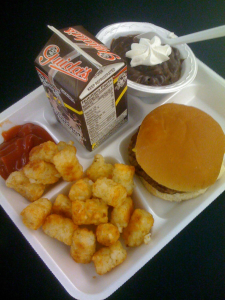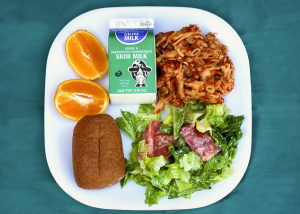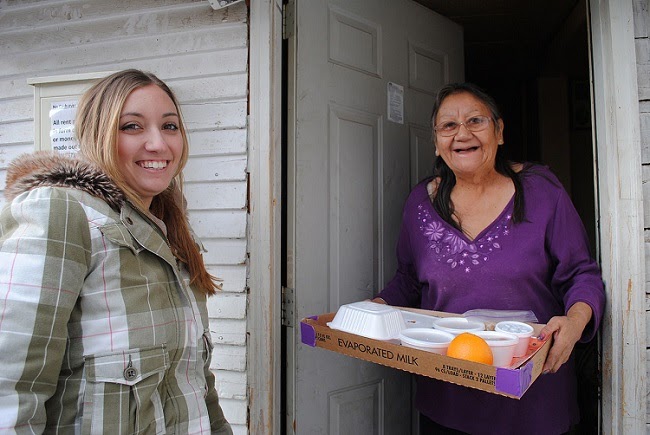Food Insecurity: An Introduction
1.3 Who Helps?
The federal government has established a number of programs that work to alleviate hunger and ensure that many low income families receive the nutrition they require to live a healthy life. A number of programs were strengthened by the passage of the Healthy, Hunger-Free Kids Act of 2010. This legislation authorized funding and set the policy for several key core programs that provide a safety net for food insecure children across the US. In addition to federal programs, many state and local governments and charitable organizations work tirelessly to help combat hunger.
The Federal Poverty Threshold and Guidelines
Each year, usually in January, the federal government publishes poverty thresholds put out by the Census Bureau, and poverty guidelines published by the Department of Health and Human Services (HHS). The threshold is used primarily for calculating all official poverty statistics. The poverty guidelines are used for determining financial eligibility for federal programs including those for food assistance. This monetary figure is the minimum amount that a family would need to acquire shelter, food, clothing, and other necessities. It is calculated based on family size and is adjusted for annual inflation. In 2020, the poverty guideline for a family of four was $26,200 for the 48 contiguous states (it’s 15-25% higher in Hawaii and Alaska). Although many people who fall below the guidelines are unemployed, the “working poor” can qualify for food programs and other forms of public assistance if their income is less than a certain percentage (125-185% depending on the program) of the federal poverty guideline, along with other qualifications.15
USDA Food Assistance Programs
Government food and nutrition assistance programs that are organized and operated by the US Department of Agriculture (USDA) work to increase food security. They provide low income households with access to food, the tools for consuming a healthy diet, and education about nutrition. The USDA monitors the extent and severity of food insecurity via an annual survey. This contributes to the efficiency of food assistance programs as well as the effectiveness of private charities and other initiatives aimed at reducing food insecurity.3
The Supplemental Nutrition Assistance Program
Formerly known as the Food Stamp Program, the Supplemental Nutrition Assistance Program (SNAP) provides monthly benefits for low income households to purchase approved food items at authorized stores. Clients qualify for the program based on available household income, assets, and certain basic expenses. In an average month, SNAP provides benefits to more than 40 million people in the US. The program provides Electronic Benefit Transfers (EBT) which work similarly to a debit card. Clients receive a card with a certain allocation of money for each month that can be used only for food. In 2018, the average benefit was about $126 per person per month (down from $134 per person in 2010), and total federal expenditures for the program were $65 billion (down from $68.2 billion in 2010).3
The Special Supplemental Program for Women, Infants, and Children (WIC)
The Special Supplemental Program for Women, Infants, and Children (WIC) provides food packages to pregnant and breastfeeding women, as well as to infants and children up to age five, to promote adequate intake for healthy growth and development. Most state WIC programs provide vouchers that participants use to acquire specific types of foods and infant formula at most food stores. In 2018, WIC served approximately 6.9 million participants per month (down from 9.2 million in 2010) at an average monthly cost of about $42 per person.3
The National School Lunch Program

The National School Lunch Program (NSLP) was established in 1946. The first year approximately 7 million children participated, and in 2018 the program had grown to almost 30 million children. The School Breakfast Program (SBP) was added in 1966. The program works to ensure that children in elementary and middle schools receive at least one healthy meal each school day, or two if both the NSLP and SBP are provided. According to the USDA, these programs operate in over 100,000 public and nonprofit private schools and residential child care institutions.16 In 2018, the programs provided meals to an average of 29.7 million children each school day. About 68% of the lunches served were free, and an additional 6% were provided at reduced prices.3 Schools are reimbursed at varying rates per state. In Texas, for example, schools received $3.41 for each free lunch they provided in the 2019-2020 school year, and $1.84 for breakfast.17 In addition to reimbursement for meals, the program provides healthy eating programming and educational materials. Figure 3.2 illustrates some of the

nutritional improvements made to school lunches as a result of the updated standards set forth by the Healthy, Hunger-Free Kids Act of 2010, compared to Figure 3.1 illustrating a “classic” school lunch. Since 2012, every school lunch must provide students a balanced meal, containing vegetables, fruit, low- or non-fat dairy, at least 50% whole grains, and lean protein. There are also limits on the amount of sodium, saturated fat, trans fat, and kcal that can be provided by the meal. All NSLP meals must meet the nutritional requirements set by Congress and the USDA, but decisions about the foods served and their preparation are made by local school authorities.16
Other Food Assistance Programs
Other government programs provide meals for children after school hours and during summer breaks. The Child and Adult Care Food Program (CACFP) offers meals and snacks at child care centers, day care facilities, and after school programs for children, and for nonprofit adult day care programs. Through CACFP, more than 4.2 million children and 130,000 adults receive nutritious meals and snacks each day.18
The Summer Food Service Program provides meals to children during summer break. Sponsors include day camps and other recreation programs where at least half of the attendees live in households with incomes below the federal poverty level.19 These and other programs help to fill in the gaps during the typical day of a food insecure child.
Head Start is a health and development program for children ages three to five, from low income families. The philosophy behind the organization is that early intervention can help address the educational, social, and nutritional deficiencies that children from lower income families often experience. Launched in 1965, it is one of the longest running, poverty-related programs in the US. Today, Head Start programs include education, meals, snacks, and access to other social services and health guidance.20
Other Forms of Assistance
Other forms of assistance include locally operated charitable organizations, such as food banks and food pantries, which acquire food from local manufacturers, retailers, farmers, and community members to give to low income families. Neighborhood soup kitchens provide meals to the homeless and other people in need. These and other organizations are run by nonprofit groups to provide an additional safety net for those in need of food.
Food Banks & Food Pantries
Food banks are nonprofit organizations that collect and distribute food to charities that work to reduce hunger. In the US there are hundreds of food banks that provide food storage and distribution depots, but do not necessarily give out food directly. Food banks in the US are very diverse—from small operations serving people spread out across large rural areas to very large facilities that store and distribute many millions of pounds of food each year, and everything in between. A variety of factors impact how food banks work, from the size of the facility to the number of staff members. Food pantries distribute food directly to those who need it, often obtaining food from food banks. There are more than 60,000 food pantries in the US located in schools, religious organizations, businesses, and many other sites in a community. Usually they distribute foods to clients once or twice per month. Both food banks and food pantries rely on food and monetary donations and volunteers to help them sort, store, and distribute billions of meals to those in need.21 If you’re considering donating to a food bank or pantry, Table 1.3.1 provides information about the items most requested and needed. Becoming a volunteer is also a great way to support these organizations.
Table 3.1 Food Bank and Food Pantry Donation Recommendations22
| Type of Donation | |
| Monetary | Monetary donations make the greatest impact. Because food banks buy in bulk, many can stretch a $10 donation into more than 40 meals and purchase food items that are already sorted and on pallets making them easier to distribute to food pantries |
| Nutritious Items* | Canned meats and fish, whole grains like quinoa or spelt, brown or wild rice, steel cut or rolled oats, whole grain cereals with at least 5 grams of fiber per serving, whole grain pastas, fruits in natural juice (no sugar added), canned vegetables (low salt or no salt added), canned fruit packed in water (not syrup), canned or boxed low sodium soups or stews, dried or canned legumes (peas, beans, lentils, peanuts), pureed foods (pumpkin, applesauce, sweet potato), low fat dry or shelf stable milk, nut butters (peanut, almond) |
| Other items to stretch food budgets | Dried herbs and spices, popcorn kernels, dried fruits, granola, shelf-stable milk substitutes (soy, almond, rice, oat), seeds and nuts (unsalted or low salt), healthy cooking oils, natural sweeteners (honey), 100% fruit juice |
| Hygiene items | Shampoo, conditioner, soap, dish soap, combs, brushes, razors, lotion, toothpaste, toothbrushes, feminine hygiene products, etc. |
| Baby items | Diapers (all sizes), baby wipes, baby food, formula |
| Cooking items | Can openers, pans, utensils, storage containers, and bags |
*Keep in mind that many clients may not have access to cooking facilities. Choose no-cook items with pop top lids or easy-to-open packaging.

Meals on Wheels
There are several other nonprofit organizations in the US that aid those who may suffer from hunger. An organization known as Meals on Wheels delivers meals to elderly people who have difficulty buying or making their own food because of poor health or limited mobility. It is the oldest and largest program dedicated to addressing the nutritional needs of senior citizens. Each day, Meals on Wheels volunteers deliver more than one million meals across the US. The first Meals on Wheels program began in Philadelphia in the 1950s. In the decades since, the organization has expanded into a vast network that serves the elderly in all 50 states and several US territories. Today, Meals on Wheels remains committed to ending hunger among the senior citizen community.10
Food For Thought
Do you believe there are enough government programs currently in place to address the problem of hunger? Why or why not? If not, what additional solutions would you recommend?
